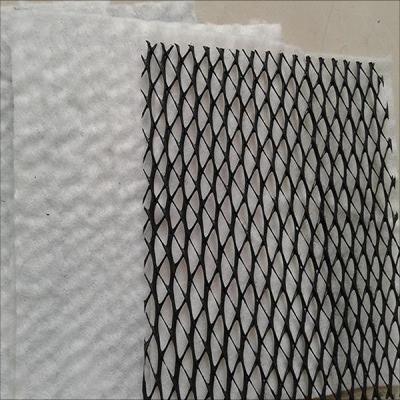Three dimensional composite drainage network It is laid between the foundation and the subbase to drain the accumulated water between the foundation and the subbase, block the capillary water and effectively integrate into the edge drainage system. This structure automatically shortens the drainage path of the foundation, greatly shortens the drainage time, can reduce the quantity of selected foundation materials used, and can prolong the service life of the road. Three-dimensional Composite drainage network Made of special three-dimensional geonet double-sided bonded geotextile. Combines geotextile (anti-filtration action) and geonet (drainage and protection action) to provide complete “anti-filtration-drainage-protection” efficacy. Laying a three-dimensional composite drainage network can help mitigate the effects of frost heave. If the freezing depth-degree is very deep, the geonet can be laid at a shallow position in the substrate as a capillary blockage. In addition, it is often necessary to replace it with a granular subbase that is not prone to frost heave, extending down to the freezing depth-degree. The backfill soil prone to frost heaving can be directly filled on the three-dimensional composite drainage network up to the ground line of the foundation. In this case, the system can be connected to the drainage outlet so that the groundwater level is equal to or below this depth-degree. In this way, the development of ice-making crystals can be potentially limited, and there is no need to limit the traffic load when the ice melts in spring in cold areas.
At present, the main connection construction method of three-dimensional composite drainage network is overlap-connection-stitching:
Lap: adjacentGeocomposite drainage network The bottom geotextile is overlapped between them. Connection: The drainage mesh core in the middle of adjacent geocomposite drainage nets is connected by iron wire, plastic cable ties or nylon belts. Stitching: The geotextile on the adjacent geocomposite drainage net layer is stitched by a portable bag sewing machine.
The unique three-dimensional structure of the three-dimensional composite drainage net core can withstand high compressive loads during the whole use process, and can maintain a considerable thickness, providing good hydraulic conductivity.
Composite anti- Drainage plate (Also known as three-dimensional composite drainage net, drainage grid) is a new type of drainage geotechnical material. With high density polyethylene ( HDPE) As raw materials, it is processed by special extrusion molding process and has three layers of special structure. The middle ribs are rigid and arranged longitudinally to form a drainage channel, and the upper and lower cross-arranged ribs form a support to prevent the geotextile from being embedded in the drainage channel, which can maintain high drainage performance even under high loads. Double-sided bonded water-permeable geotextile is used in combination, which has the comprehensive properties of “reverse filtration-drainage-breathability-protection” and is currently an ideal drainage material.
Post time: Mar-14-2025




